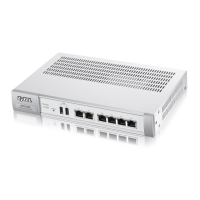Chapter 9 Interfaces
NXC Series User’s Guide
174
9.5 Technical Reference
The following section contains additional technical information about the features described in this
chapter.
IP Address Assignment
Most interfaces have an IP address and a subnet mask. This information is used to create an entry in the
routing table.
In most interfaces, you can enter the IP address and subnet mask manually.
In many interfaces, you can also let the IP address and subnet mask be assigned by an external DHCP
server on the network. In this case, the interface is a DHCP client.
In general, the IP address and subnet mask of each interface should not overlap, though it is possible for
this to happen with DHCP clients.
In the example above, if the NXC gets a packet with a destination address of 5.5.5.5, it might not find
any entries in the routing table. In this case, the packet is dropped. However, if there is a default router
to which the NXC should send this packet, you can specify it as a gateway in one of the interfaces. For
example, if there is a default router at 200.200.200.100, you can create a gateway at 200.200.200.100 on
ge2. In this case, the NXC creates the following entry in the routing table.
The gateway is an optional setting for each interface. If there is more than one gateway, the NXC uses
the gateway with the lowest metric, or cost. If two or more gateways have the same metric, the NXC
uses the one that was set up first (the first entry in the routing table).
If the interface gets its IP address and subnet mask from a DHCP server, the DHCP server also specifies
the gateway, if any.
Interface Parameters
The NXC restricts the amount of traffic into and out of the NXC through each interface.
• Egress bandwidth sets the amount of traffic the NXC sends out through the interface to the network.
• Ingress bandwidth sets the amount of traffic the NXC allows in through the interface from the
network.
1
If you set the bandwidth restrictions very high, you effectively remove the restrictions.
The NXC also restricts the size of each data packet. The maximum number of bytes in each packet is
called the maximum transmission unit (MTU). If a packet is larger than the MTU, the NXC divides it into
smaller fragments. Each fragment is sent separately, and the original packet is re-assembled later. The
smaller the MTU, the more fragments sent, and the more work required to re-assemble packets correctly.
Table 73 Example: Routing Table Entry for a Gateway
IP ADDRESS(ES) DESTINATION
0.0.0.0/0 200.200.200.100
1. At the time of writing, the NXC does not support ingress bandwidth management.

